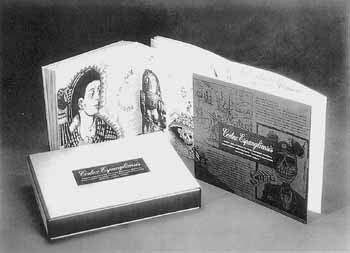New World Disorders
New MAH exhibit paints a portrait of cultural collisions
By Mary Spicuzza
IN THE WORLD OF most people, Wonder Woman has little to do with ancient scripture, and Mickey Mouse never met the Mayans during the Spanish conquest. But in the eyes of three artists bound together in Codex Espangliensis: From Columbus to Border Patrol, these pop-culture icons have everything to do with the unfolding tale of border politics at the century's end.
"Will the predatory Statue of Liberty devour the contemplative Virgin of Guadalupe or are they merely going to dance a sweaty quebradita?" poet Guillermo Gómez-Peña asks in the work's text.
The project, currently on display at downtown Santa Cruz's Museum of Art and History, is a collaboration between Gómez-Peña, Enrique Chagoya and local book artist Felicia Rice. Although offering few definitive answers to its surreal questions, the book--really more of a multimedia performance piece--adds a whole new depth to questions of cultural collisions and border politics.
Using everything from cartoon icons to woodcuts of pre-Hispanic indigenous peoples and Mayan history, the codex explores the often harsh, mostly surreal realities of border culture at the century's end.
Gómez-Peña, a renowned poet, journalist and performance artist originally from Mexico City, provides the written text while Chagoya, a Mexican- born artist and former director of San Francisco's Galeria de la Raza, contributes a cross-cultural collage of images.
"Ours is sort of a noncollaborative collaboration ... a happy--yet accidental--arrival at the same place," Chagoya says, further explaining that he treasures the exhibit for its balance of emphasis on words and imagery.
One of the outstanding aspects of the book is its ability to use the absurd to represent reality. Everyone knows Mickey Mouse wasn't there when the Spanish were torturing Aztecs who resisted colonization, but the codex points to Disney's current global expansion as a contemporary cultural equivalent of manifest destiny.
Meanwhile, in another nearby spread, Spiderman with a George Washington head climbs over Gómez-Peña's text, which reads, "Whether we like it or not, a new era has begun, and a new economic and cultural topography has been designed for us."
FOR ONCE, bookwork is also getting equal time in the spotlight. Rice, a book artist, typographer and founder of Moving Parts Press, assembled the folded book--31 feet at full extension--using Western European bookmaking and Japanese bookbinding techniques. Printed in basic red and black hues on Mexican amatl paper lined with Japanese shintengujo tissue, the codex is truly an exercise in cultural collaboration.
Moving Parts Press has been a local legend for producing innovative books since 1977. Rice saw the project through two moves of the press, on both occasions transporting 15,000 pounds of equipment.
While topics like NAFTA, global imperialism, genocide of indigenous peoples and the destruction of pre- Hispanic texts are never going to be lighthearted topics, the trio presents them in a way that is neither defeatist nor depressing.
"We still believe in the transformative power of art," Gómez-Peña says of the creative trio, "and most importantly, we have a thorny sense of humor with the following dictum: 'Respect nothing or no one, not even yourself.'"
[ Santa Cruz | MetroActive Central | Archives ]
Copyright © Metro Publishing Inc. Maintained by Boulevards New Media.
![]()

Book Marked: 'Codex Espangliensis' puts a contemporary spin on Latin history by meshing pop culture and politics.
Codex Espangliensis: From Columbus to the Border Patrol shows at MAH through Sept. 27. A reception on Sept. 9 (7-9pm) features readings, a slide presentation and brief history by the artists.
From the August 27 - September 2, 1998 issue of Metro Santa Cruz.
![[MetroActive Arts]](/gifs/art468.gif)